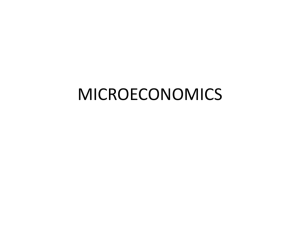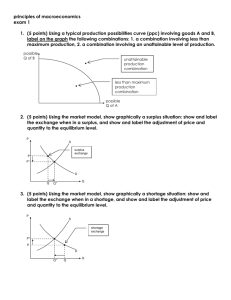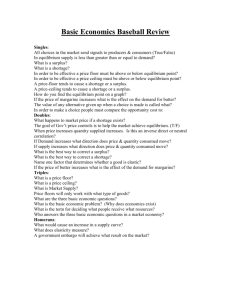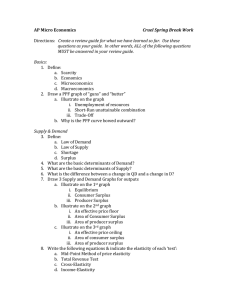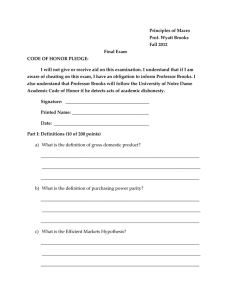Study Guide for Micro Econ Unit 3
advertisement
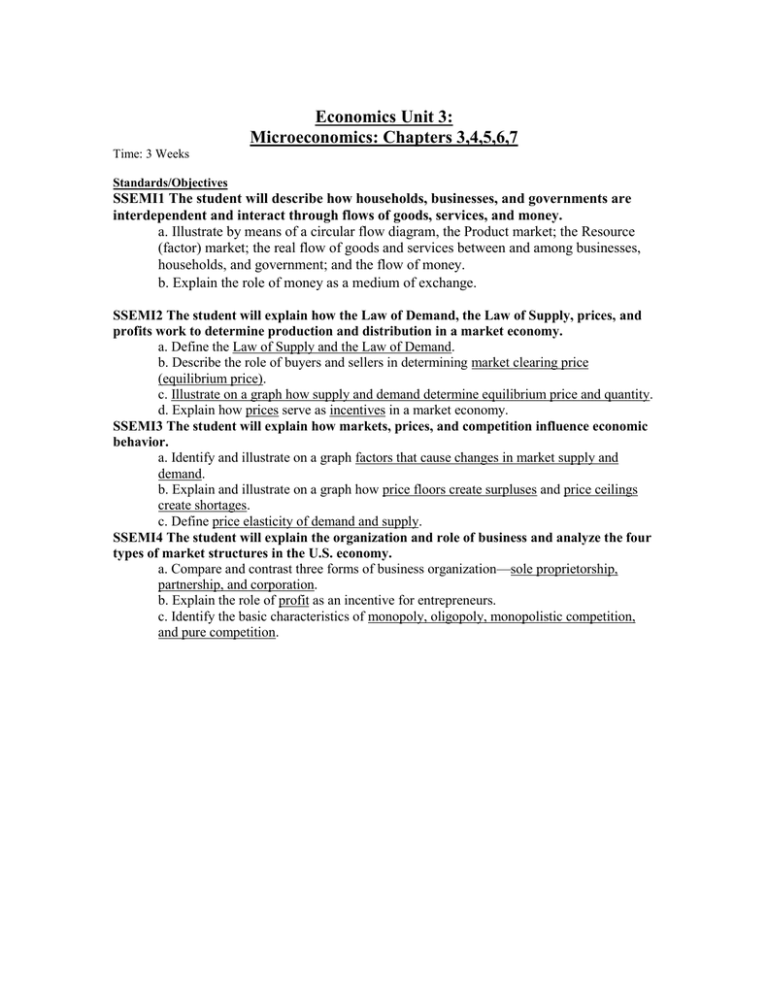
Economics Unit 3: Microeconomics: Chapters 3,4,5,6,7 Time: 3 Weeks Standards/Objectives SSEMI1 The student will describe how households, businesses, and governments are interdependent and interact through flows of goods, services, and money. a. Illustrate by means of a circular flow diagram, the Product market; the Resource (factor) market; the real flow of goods and services between and among businesses, households, and government; and the flow of money. b. Explain the role of money as a medium of exchange. SSEMI2 The student will explain how the Law of Demand, the Law of Supply, prices, and profits work to determine production and distribution in a market economy. a. Define the Law of Supply and the Law of Demand. b. Describe the role of buyers and sellers in determining market clearing price (equilibrium price). c. Illustrate on a graph how supply and demand determine equilibrium price and quantity. d. Explain how prices serve as incentives in a market economy. SSEMI3 The student will explain how markets, prices, and competition influence economic behavior. a. Identify and illustrate on a graph factors that cause changes in market supply and demand. b. Explain and illustrate on a graph how price floors create surpluses and price ceilings create shortages. c. Define price elasticity of demand and supply. SSEMI4 The student will explain the organization and role of business and analyze the four types of market structures in the U.S. economy. a. Compare and contrast three forms of business organization—sole proprietorship, partnership, and corporation. b. Explain the role of profit as an incentive for entrepreneurs. c. Identify the basic characteristics of monopoly, oligopoly, monopolistic competition, and pure competition. Study Guide CHAPTER 3, SECTION 1: FORMS OF BUSINESS ORGANIZATION CAN I: 1. Describe what I study when I study microeconomics? 2. Define sole proprietorship, partnership, and corporation? 3. Identify advantages and disadvantages of establishing my business as a sole proprietorship? 4. Identify advantages and disadvantages of establishing my business as a partnership? 5. Identify advantages and disadvantages of establishing my business as a corporation? (for #3-5, focus on ease of organization, access to capital, taxation, control, liability, specialization, flexibility, decision-making, and life of your firm) 6. Define specialization and describe its advantages? 7. Describe what a shareholder in a corporation is? Chapter 3, Section 2: Business Growth and Expansion CAN I: 1. Describe how a firm can grow internally to grow and expand. 2. Give five reasons why firms merge. 3. Explain the different ways businesses can merge. CHAPTER 3, SECTION 3: OTHER ORGANIZATIONS CAN I: 1. Define labor union and collective bargaining? CHAPTER 4, SECTION 1: CAN I 1. Describe the basic unit of study in microeconomics? 2. Define demand? 3. Define the law of demand? CHAPTER 4, SECTION 2: CAN I 1. Describe the difference between change in quantity demanded and change in demand? 2. Identify the factors that cause a change in demand? 3. Demonstrate on a graph a shift in demand? (Increase direction of shift? Decrease direction of shift?) 4. Provide a real world example of something that would shift the demand curve for a product to the right? CHAPTER 4, SECTION 3: CAN I 1. Define elasticity of demand? Define inelastic demand? 2. Answer a question like: “If the price of a product increases greatly, and its demand does not decrease much, what type of demand does the product have?” 3. Identify the factors that determine whether or not a product has an elastic demand? CHAPTER 5, SECTION 1: CAN I 1. Define supply? 2. Define the law of supply? 3. Describe the difference between change in quantity supplied and change in supply? 4. Identify the factors that cause a change in supply? 5. Demonstrate on a graph a shift in supply? (Increase direction of shift? Decrease direction of shift?) 6. Provide a real world example of something that would shift the supply curve for a product to the right? CHAPTER 6, SECTION 1: CAN I 1. Explain how prices act as signals in a market? 2. Explain how prices motivate both buyers and sellers in a market economy? CHAPTER 6, SECTION 2: CAN I 1. Define equilibrium price? 2. Describe what causes a surplus and shortage? 3. Interpret a supply and demand graph when either supply or demand curve shifts? 4. Identify the equilibrium price on a supply and demand graph? CHAPTER 6, SECTION 3: CAN I 1. Define a price floor and identify the effects of it? (surplus or shortage?) 2. Define a price ceiling and identify the effects of it? (surplus or shortage?)’ 3. Identify whether the minimum wage is a floor or ceiling? Describe the economic effects of a minimum wage? 4. Explain how supply and demand affect wages and salaries in a market economy? CHAPTER 7, SECTION 1: MARKET STRUCTURES CAN I: 1. Describe the characteristics of a perfect competition market structure? 2. Describe the characteristics of a monopolistic competition market structure? 3. Describe the characteristics of an oligopoly market structure? 4. Describe the characteristics of a monopoly market structure? (for #1-4, focus on control over price, ease of entry into market for a new business, product differentiation, number of firms in the market, capital costs, competition level, interdependence between businesses) 5. Provide an example of each of the market structures above? 6. Define and give an example of the following types of monopolies: a) natural b) technological (patent) c) geographic CHAPTER 7, SECTION 2 AND 3: MARKET FAILURES AND THE ROLE OF GOVERNMENT CAN I: 1. Describe and give examples of negative externalities? 2. Explain what public goods are and how they are paid for in the United States? 3. Provide examples of public goods? 4. Explain why the government provides public goods? 5. Identify what type of government intervention promotes market competition? 6. Describe the probable effects of government deregulation on competition between firms?

